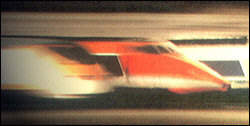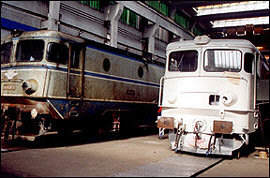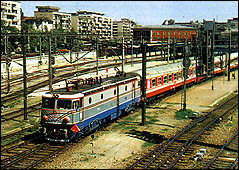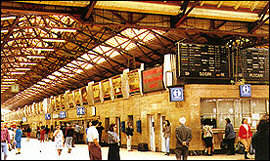 LAND TRANSPORT LAND TRANSPORT |

When doing business in Romania, one of the first things that strikes the visitor is how spread out are the companies throughout the whole national territory. This was again one of Ceausescu's policies: almost every town in Romania has its own factory or industrial cluster. As a consequence of this the development of the transport sector is of crucial importance for industrial growth.
Romania has a road network of 73,260 Km, out of which 14,683 Km are national roads (20% of the total system). Compared with other European countries, the density is very small, 0.64 Km/ Sq. Km. Only 24,6% of the roads have been modernized. Thus, despite the economic austerity measures set by Prime Minister Isarescu, the Ministry of Transports' budget is the only one that has not experienced cuts. In fact, the Ministry's first priority is the rehabilitation of national roads, since 70% of the traffic runs through them. The Secretary of State for Land Transport, administered by Mr. Adrian Marinescu is in charge of bringing the Romanian roads to Western European standards. There are already several projects under construction. In fact, in 1998, 960 Km of national roads were rehabilitated, and a second project finishing up in 2000 will upgrade 700 Km more. Mr. Marinescu expects that by the year 2006 all national roads will be restored.
But it is specially the highway network that needs to be expanded. Today only 13 Km of roads are highways. A set of ambitious projects to create new highways are already being worked out and financed by the EBRD, the EU - through the PHARE Program - or the European Bank for Investments. These programs envisage the creation of highways between the most industrially developed cities such as Bucharest-Pitesti or links to the port (Bucharest-Constanta), as well as the construction of belts around the 5 largest cities along the European Corridor number 4. The Secretary of State Mr. Marinescu boasts that the fourth phase of this ambitious program will be finished by 2006 and covering 2,600 Km of highways.
Railways are playing with advantage. During the previous regime, rail transportation was favored before road transport. However, the fast increase of trucks and cars is soon catching up. To speed up the railway modernization process in 1998 the national company CFR, was split into 6 smaller and highly specialized companies. CFR S.A. is responsible for the management of the railway infrastructure and of the auxiliary railway patrimony. CFR Passengers (or CFR Calatori) performs the public passanger rail transport. CFR Marfa transports freight by rail. SAAF is in charge of managing the surplus of assets resulting after the restructuring of CFR. SMF was set up to ensure financial, accounting and legal services. Finally the National Company of Romanian Railways Administration administers the debts existing at the date of the reorganization of the railways.
Mr. Marinescu claims, without being modest, that Romania "is among the first countries in Europe to have applied the European directives in the railway field", adding that "we have accomplished what the European directive required, i.e. to separate infrastructures from the operators". And they all seem to be doing quite well, or so it looks when looking at their turnover and profits.

SAAF (the Rail Assets Management Company) is a good example of that. Mr. Mircea Dinu, its General Director, explains the sharp decline experienced by Romanian railways in the 1990's. "In the 80's it was among the first railways in Europe in terms of revenue and business volume, but due to the performance of the Romanian economy today the chore of the Romanian operating railways represents 30% of what it was in 1988-89". Obviously something had to be done with the excess of rail assets, that was the reason for the creation of SAAF. Today they have at their disposal 60,000 wagons, 2,000 locomotives, installations, marshalling yards, real state, etc, and their main task is to bring all these into operations. In one year they were able obtain US$ 30 million of profits, especially by leasing their locomotives in Germany, Italy or Iran and the sale of wagons as iron scrap. Their expected for 2000 is US$ 60 million.
Mr. Dinu claims that the secret of their success is that they offer a soft package to their customers, i.e. "we provide all the logistics for maintenance and operation of the goods. Our clients basically focus on operating the machinery and we provide them with all the required services". The customers are satisfied and pay promptly, and the money obtained is reinvested in new rolling stock and equipment for the modernization of the rest of the railway companies.
| Investment in infrastructures is an expensive business, so The National Company of infrastructures, CFR S.A. can very well do with the funds pumped in by SAAF. However, Mr. Viorel Simut, its General Manager, is also set to obtain funds from an array of different sources. Mr. Simut specifies that the decrease in railroad transport is due to the slowdown of the economy and to the changes experienced by it. His major concerns are to maintain the 22,000 Km rail infrastructures and to modernize them. Today the average speed is 105 Km/hr, when the average in the rest of Europe is 150 Km/hr. Hence CFR S.A's primary aim is to improve infrastructures so that trains will be able to circulate at least at 160 Km/hr.

But CFR S.A. has other sources of finance. It has recently started to exploit its railway stations renting space for shops and restaurants. Jokingly Mr. Simuts defines the future Romanian railway station "as a big shopping area where people come to shop and where, by chance, there are trains coming and going". From1998 to 2000 they were able to multiply by 6 their benefits in space rental. For the year 2000 they expect to reach US$ 11.2 million, and the goal for 2010 is US$ 112 million. The exploitation of Hotels, the development of optic fibers, the modernization of railway stations and the electrification of large chunks of infrastructures are some of the ambitious plans the General Manager of CFR S.A. keeps up his sleeve.

In fact, the splitting of the former CFR has benefited all companies that have resulted from the break-up through a better knowledge of incomes and expenditures of the whole rail sector. CFR Passengers, another spin-off of the previous monolithic CFR has reduced expenses considerably. This has been achieved not only through the elimination of more than 7,000 redundant personnel in one year and 3 months, but also by the reduction of expenses. CFR Passengers obtained profits for the first time in 1999. The modernization process of CFR Passengers (or CFR Calatori) is in full fledge, since they want to offer the best possible service to their passengers. Of the 4,400 wagons and 800 locomotives the company owns, they have successfully modernized 24 locomotives and 200 wagons, having recently signed a contract for the modernization of 100 wagons more.
CFR Calatori operates daily 1,735 trains carrying 12 million passengers per month. Due to this huge volume, in order to obtain a better performance through the whole country, CFR Calatori has been further split into 9 companies. Local authorities have been involved into the 8 short-distance regional companies. CFR Calatori exclusively takes care of long distance. For this purpose CFR Passengers is already on discussions to operate fast trains that will reach Hungary and Austria in much shorter times. "Through these agreements we want to attract more passengers for international traffic. When the Romanian citizens will be able to travel around Europe without visa the traffic will be, of course, much higher", concludes the General Manager of CFR Passengers, Mr. Valentin Bota. Following the diversification and international market trends, CFR Calatori has restored a few turn-of-the-century trains, offering voyages that go back in time in some of the most beautiful regions of Romania.
CFR Marfa, the freight company, only transports goods. However due to the decrease of production of most goods in Romania, it is probably the company within the group that has been affected most. According to Mr. George Buruiana, General Manager of CFR Marfa, in 1989 80% of the transport of goods was done by rail. In 2000 that percentage decreased to 37%, even though its performance has slightly improved in the last 6 months. To further reduce costs, CFR Marfa wants to privatize 4 of its branches: combined transport, trans-shipments and wagon washing facilities. The main task for 2000 is to establish a joint venture with Hungarian, Austrian, German and Bulgarian rail transport companies for the creation of a central European freight transport company. This new entity would allow CFR Marfa to expand beyond Romanian frontiers while broadening the services offered. |

